This incredible slow-roasted shoulder of Welsh Lamb is cooked with the veggies – all in the same pan! Served with an easy cider gravy this succulent lamb is a real crowd-pleaser.
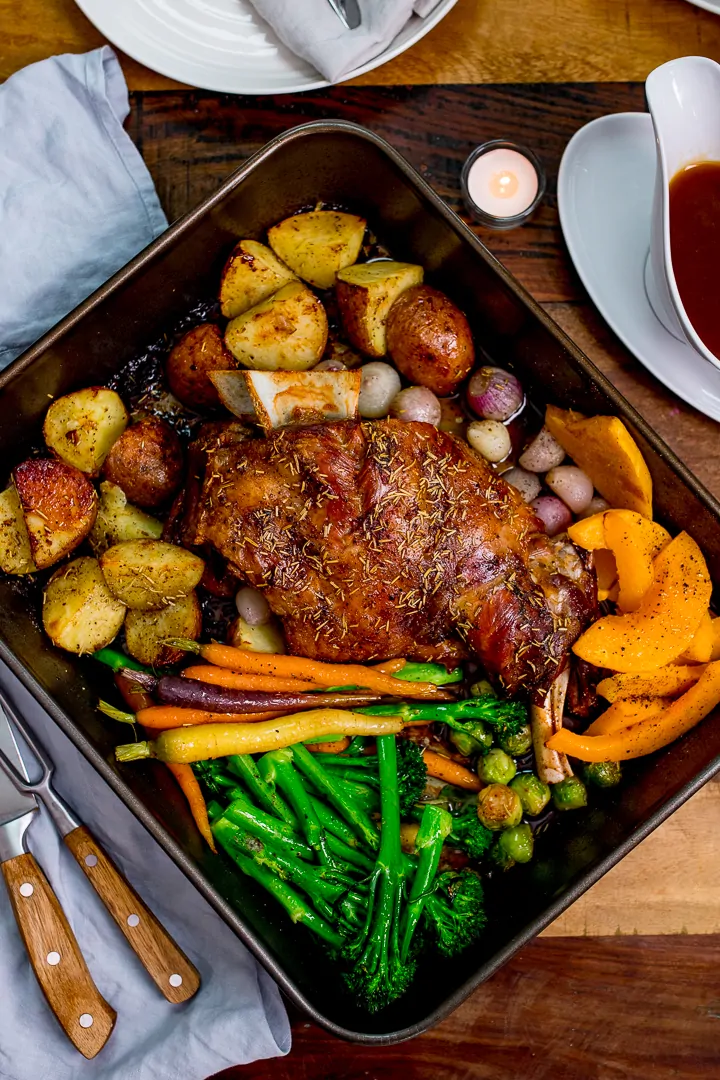 This post was created in partnership with PGI Welsh Lamb. All opinions are my own.
This post was created in partnership with PGI Welsh Lamb. All opinions are my own.
If I were to ask you “When is the perfect time to eat lamb?” What would you say?
Easter?
I know that’s what I’d have said up until recently. But then I discovered that lamb – or more specifically Welsh Lamb (which is the best – and I’ll tell you why in a minute) is actually at it’s absolute best from the beginning of August through to November. I know right?
Chris and I recently spent a fantastic couple of days down in south Wales, learning all about lamb.
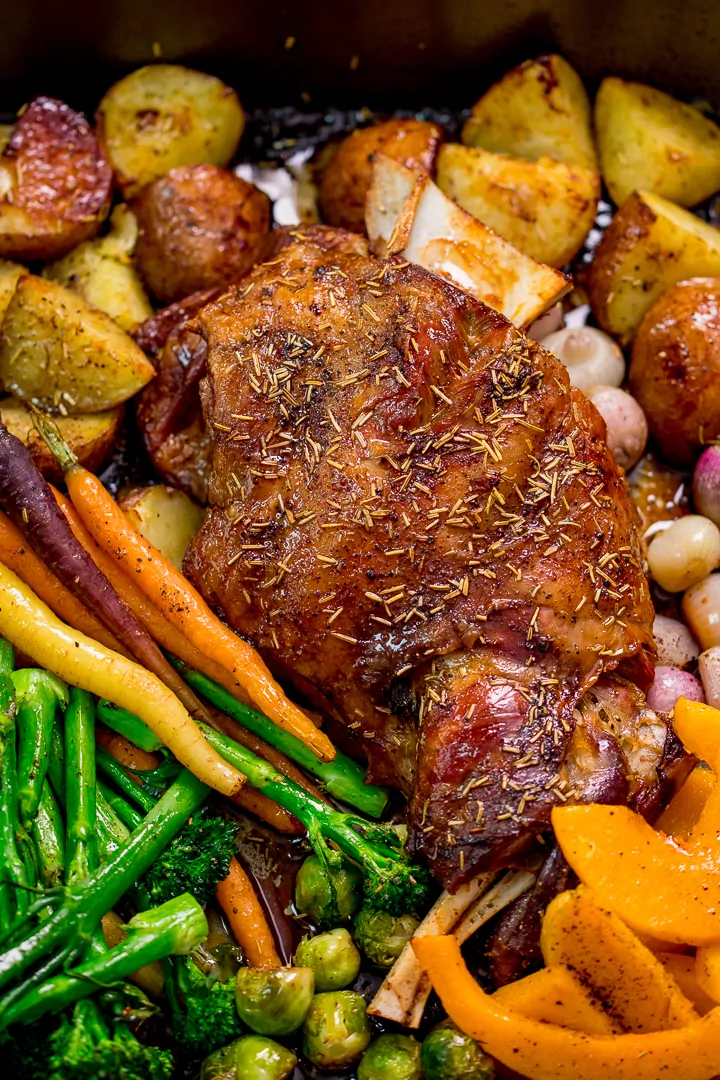
- We visited the Salt Marshes at Gower Salt Marsh Lamb
- We learned about the many different cuts of lamb at a butchery session at Hugh Phillips
- We had a masterclass session with Head Chef Hywel Griffith
- We were fed a fantastic 4-course dinner (cooked by Hywel and his team) at the Beach House Restaurant in Oxwich Bay, right on the beach.
I’ll share some pics with you further on down this post, but first…
Why is Welsh Lamb the best?
We eat lamb a lot, and I didn’t really take a lot of notice of where it came from. BUT, I had noticed that the lamb we often buy from a little farm shop on our way home from our regular trips to Wales, is always the best lamb.
– It turns out that a big factor is the amount of rain there is in Wales (which, is a lot!).
– All of that rain ensures the finest juicy grass for the sheep to graze freely on – whether it’s luscious pastureland, or the highly nutritious salt marshes.
– They’re also reared using traditional farming methods that date back centuries. One of my favourite parts of the trip was watching the sheep dogs expertly zipping around, rounding up the sheep and seeing them safely to the field before the tide came in.
With Love Lamb Week coming up (1st-7th September 2019), I wanted to show you an easy way to get delicious lamb dinner on the table.
No par-boiling potatoes, no peeling of carrots and no need to install a second sink to fit in all of the pots and pans that the average roast dinner requires!
- We start off by drizzling oil onto a big shoulder of lamb, then sprinkling with salt, pepper and rosemary, covering with foil and placing in the oven for 3 hours.
- After three hours, baste the lamb and add in the potatoes (adding oil and seasoning again) for 15 minutes.
- Then add in carrots, shallots, butternut squash and sprouts. Toss all of the vegetables in the fat and meat juices in the pan. Back into the oven for 15 minutes.
- Then add tenderstem broccoli and lightly season, before placing back in the oven for a final 15 minutes.
Remove from the oven and place the vegetables and lamb on a warm serving plate to rest while you make the gravy.
- Place the roasting tin over a medium-high heat and pour in the cider.
- Scrape up all of the bits from the pan and simmer for a few minutes.
- Then add in lamb stock and bring to the boil. Stir in a little cornflour (cornstarch) slurry to thicken.
 Serve with the lamb and veggies.
Serve with the lamb and veggies.
Alternative joints of Welsh Lamb:
- If you’d prefer to use a leg of lamb, then use a 1.8kg-2kg leg of lamb – with the same temperature and timings.
- You could also use a boneless rolled leg or boneless rolled shoulder of lamb.
Joints of meat are much more flavourful and juicy when cooked with the bone in, but it is easier to carve a boneless joint. Boneless joints are usually smaller, so you’ll need to reduce the cooking time accordingly.
Most advice calls for 25-30 minutes of cooking per 450g/1 lb plus 25-30 minutes. I would also add an extra 30 minutes cooking time for the whole dish (including the vegetables), this is because adding vegetables to the tin, slows down the cooking of the lamb.
So let’s have a look at a few pics! If you want to get straight on with the recipe, the recipe video and full recipe card are at the bottom of this post.
First was our trip to Gower Salt Marsh Lamb where we saw the lambs roaming the salt marshes (you might be able to see them as tiny little specks in the first image). The salt marshes are abundant with all sorts of nourishing goodies for the lambs to graze on – such as samphire, sorrel, sea lavender and Thrift.
The lambs were expertly rounded up by the sheep dogs and farmers who moved the sheep over to the pastured field before the tide came in (a few wild horses went along for the ride too!). The sheep dogs were the sweetest things, and you can see below how much they love their owners.
After the salt marshes we headed over to Hugh Phillips butchers for a butchery session. It was amazing to see the variety of cuts available. It’s too easy to think of lamb chops, leg and shoulder as the only cuts available. I counted about 14 or 15 cuts here, and it was interesting to hear how they focus on different cuts depending on the season. i.e more diced lamb over winter – for stews and casseroles. More mince and ribs over the summer for burgers and barbecues.
Next we headed over to the Beach House Restaurant in Oxwich Bay for a masterclass session with Head Chef Hywel Griffith. I’ve got to admit, I was a little alarmed at the faggot-making process (offal scares me), but I had a little taste, and they were good! We also watch Hywel prepare a loin of lamb with laverbread sauce – which was delicious! Notice on one of the images, there’s a bottle of ‘lamb fat‘. I think that needs to be a new addition to my kitchen!
Hywel and his team then treated us to a fantastic meal at his restaurant. Check out the view from the patio outside. So pretty!
We ate:
- Laverbread loaf with salted butter
- Charred mackerel fillet with anchovy mayonnaise and avocado
- Hay smoked lamb with pearl barley and mushroom ketchup
- Salt marsh lamb with carrot and caraway puree
- Hazelnut treacle tart with vanilla and lime clotted cream ice cream
We were spoiled rotten on this trip, and it was so great to see the versatility as well as the provenance of PGI Welsh Lamb.
I couldn’t wait to get home to get in the kitchen and make this roasted shoulder of lamb (we even stopped off at a farm shop and bought more Welsh lamb for a curry ha ha).
Will you be cooking lamb this Sunday? At this time of year you can find Welsh lamb available in most supermarkets.
Slow Roast Shoulder of Lamb recipe video:
If you’d like to see some more recipes from my fellow foodies who also came on the trip, check these out below:
- Welsh Lamb Kebabs from Jane at The Hedge Combers
- Welsh Lamb Bombay Hotpot – from Pippa at The Slimming Foodie
- Welsh Lamb Paella from Eb at Easy Peasie Foodie
- I’ve also done another delicious lamb recipe recently – Lamb Carnitas – served on warmed tacos with ALL the toppings!
The Slow Roast Shoulder of Lamb Recipe:
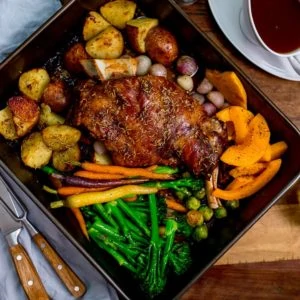
Slow roast lamb shoulder recipe
Ingredients
- 2-2.2 kg (4.4 - 4.8 lbs) shoulder of lamb
- 3 tbsp olive oil
- 1 tsp salt
- 1 tsp black pepper
- 1 tsp dried rosemary
- 4 medium red-skinned potatoes chopped into large chunks (no need to peel)
- 10 small carrots peeled with trimmed tops
- 10 shallots peeled
- ½ butternut squash peeled and sliced into 1cm-thick half-moons
- 12 sprouts
- 200 g (4 oz) tenderstem broccoli
Cider Gravy
- 150 ml (1/2 cup + 2 tbsp) cider hard cider if you're in the US
- 300 ml (1 1/4 cups) lamb stock
- 2 tbsp cornflour (cornstarch) mixed with 4 tbsp cold water to make a slurry
Instructions
- Preheat the oven to 180C/350F (fan). Place the lamb in a large baking tin and score the fatty bits of the lamb lightly with a sharp knife.2-2.2 kg (4.4 - 4.8 lbs) shoulder of lamb
- Rub on one tablespoon of the olive oil, then sprinkle on half of the salt, pepper and rosemary (1/2 tsp of each). Cover the tin with foil (tent it over the lamb, so it’s not actually touching the lamb) and place in the oven for 3 hours (this will give you well-done but juicy lamb. Cook for 2 hours and 15 minutes if you like your lamb a little rarer).3 tbsp olive oil, 1 tsp salt, 1 tsp black pepper, 1 tsp dried rosemary
- After 3 hours, remove the foil and baste the lamb.
- Arrange the potatoes in the tin around the lamb. Drizzle the remaining oil onto the potatoes and sprinkle on half of the remaining salt, pepper, and rosemary (1/4 tsp of each).4 medium red-skinned potatoes
- Place back in the oven to cook, uncovered for 15 minutes
- Open the oven and turn the potatoes. Add the carrots, shallots, butternut squash and sprouts. Turn them in the oil and meat juices to coat, then place them back in the oven for a further 15 minutes.10 small carrots, 10 shallots, ½ butternut squash, 12 sprouts
- Open the oven and add the broccoli. Turn to coat in the oil and meat juices and sprinkle the remaining salt, pepper, and rosemary (1/4 tsp of each) onto all of the vegetables. Place back in the oven for a final 15 minutes.200 g (4 oz) tenderstem broccoli
- Remove from the oven and place the lamb and vegetables on a warm serving plate, then cover with foil and leave to rest for 10 minutes whilst you make the gravy.
- Add the cider to the meat juices in the roasting pan (alternatively you can transfer the meat juices from the roasting pan to a saucepan – scrape it clean so you get all the flavour and boil for 5 minutes until reduced by half.150 ml (1/2 cup + 2 tbsp) cider
- Add the stock and bring back to the boil. Slowly pour in the cornflour and water mixture whilst stirring until the gravy has thickened. Give it a little taste and add a little salt and pepper if required.300 ml (1 1/4 cups) lamb stock, 2 tbsp cornflour (cornstarch)
- Remove the foil from the lamb and serve with the cider gravy.
Video
Notes
Nutrition
Nutrition information is automatically calculated, so should only be used as an approximation.
Some of the links in this post may be affiliate links – which means if you buy the product I get a small commission (at no extra cost to you). If you do buy, then thank you! That’s what helps us to keep Kitchen Sanctuary running. The nutritional information provided is approximate and can vary depending on several factors. For more information please see our Terms & Conditions.
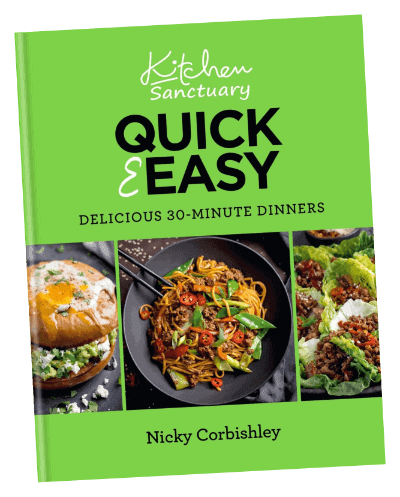
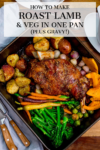


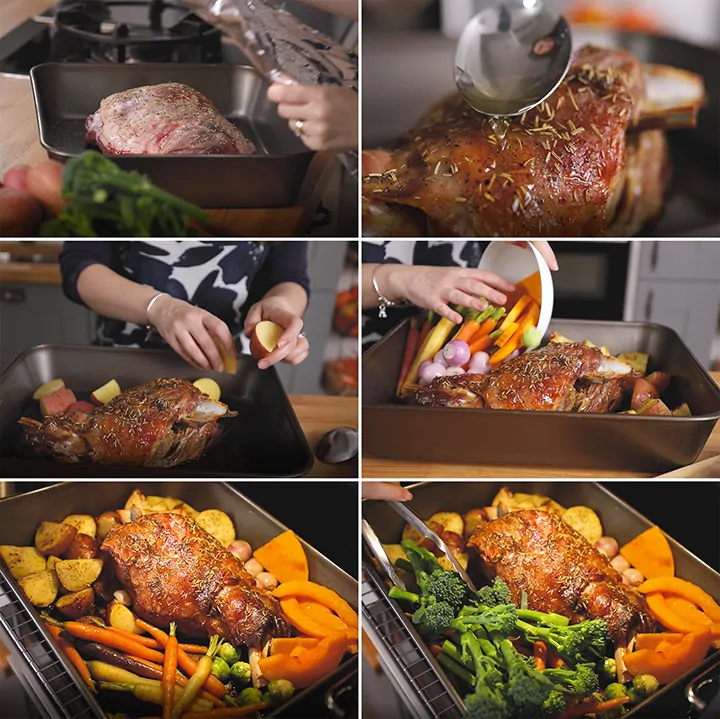
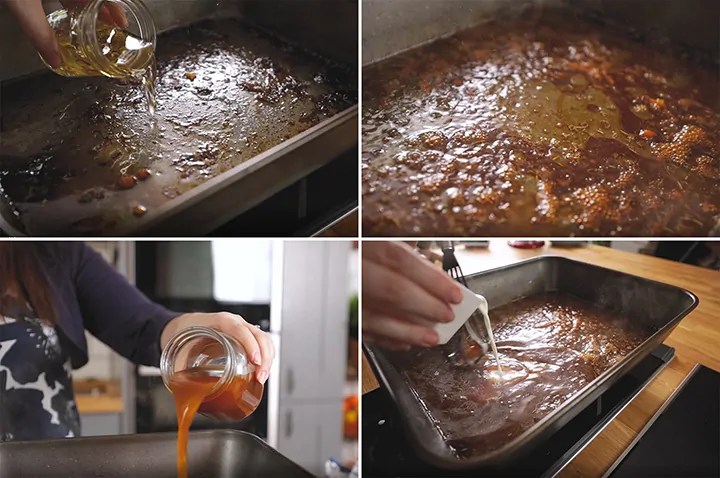
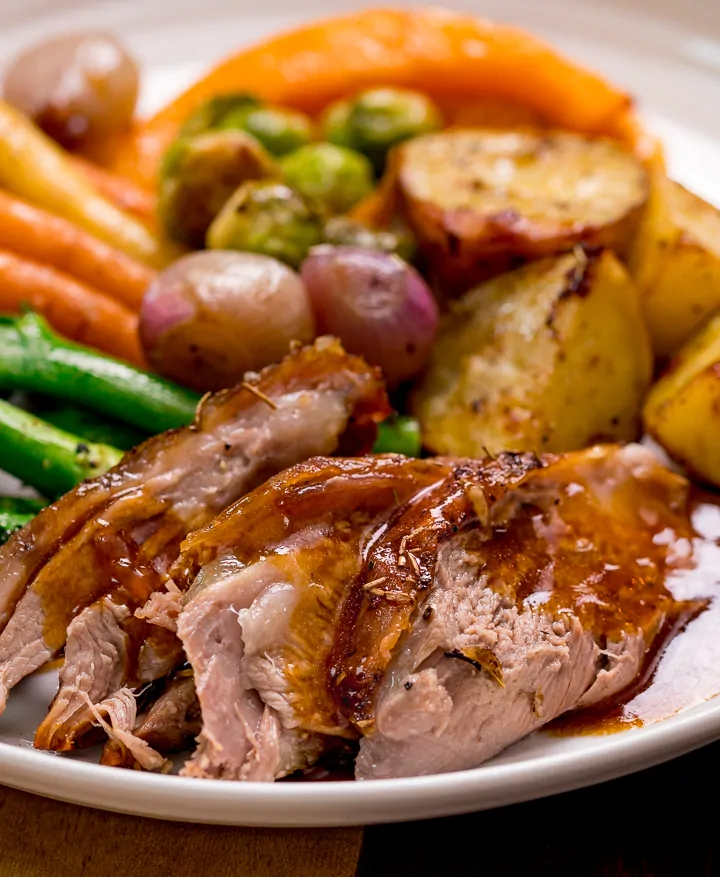
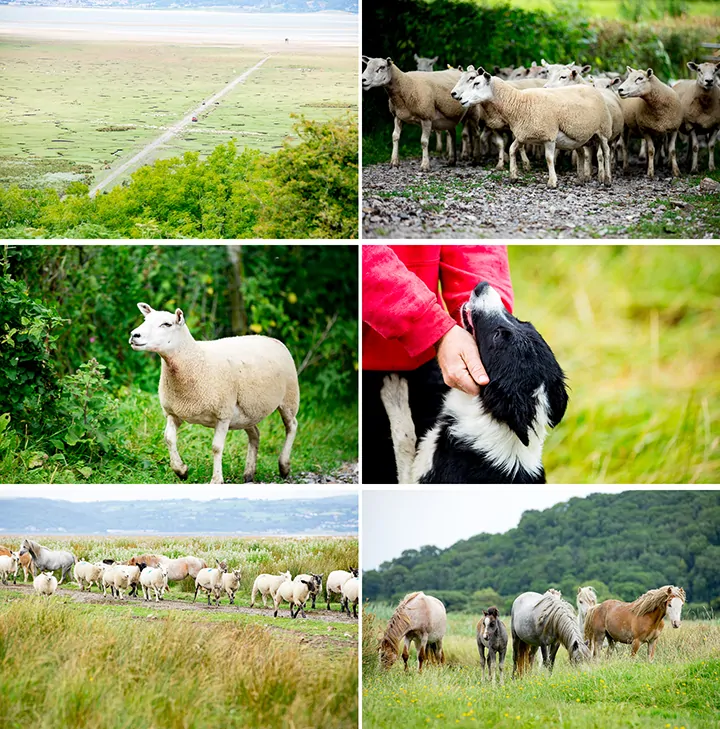
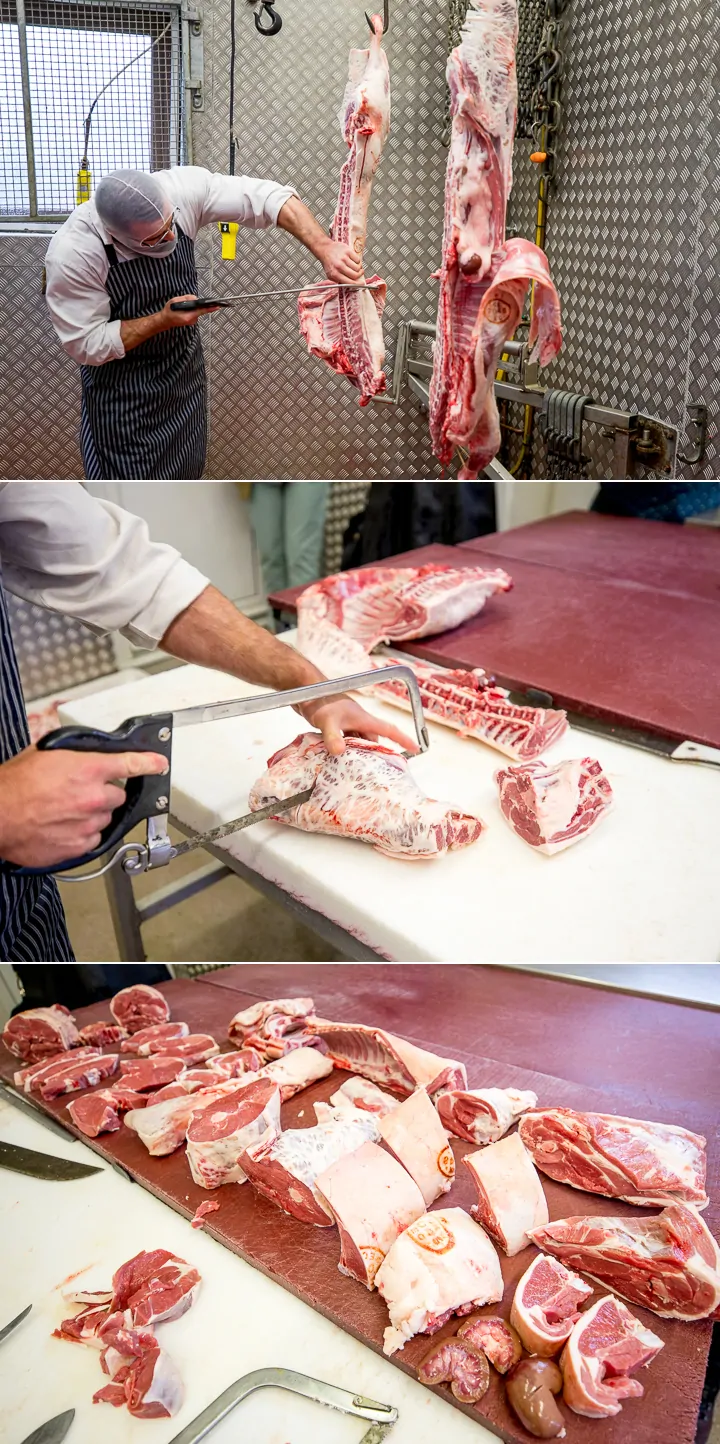
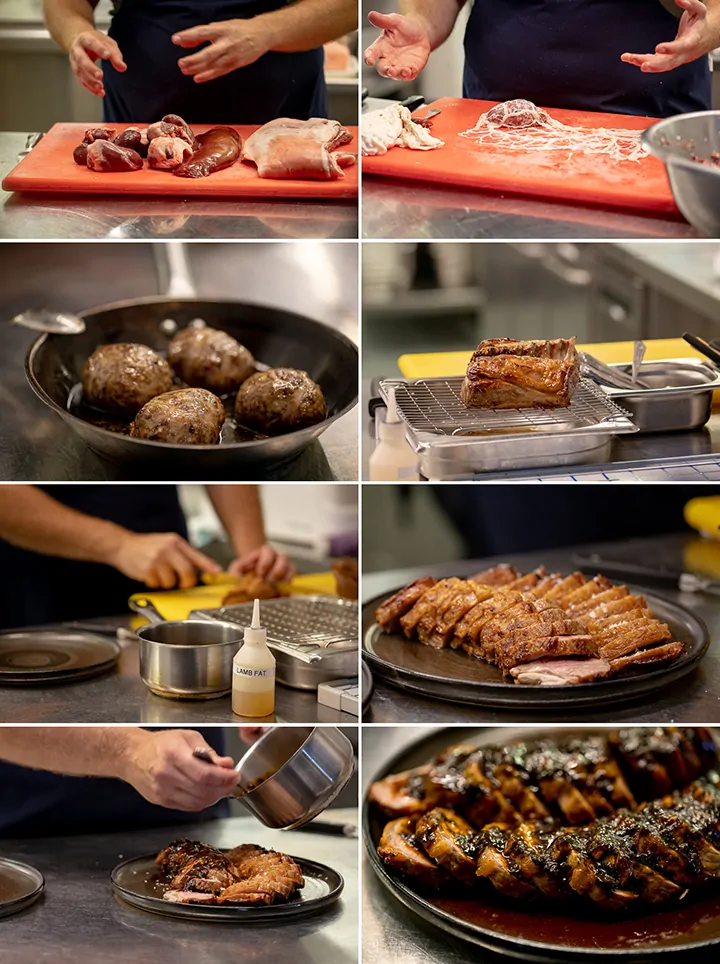
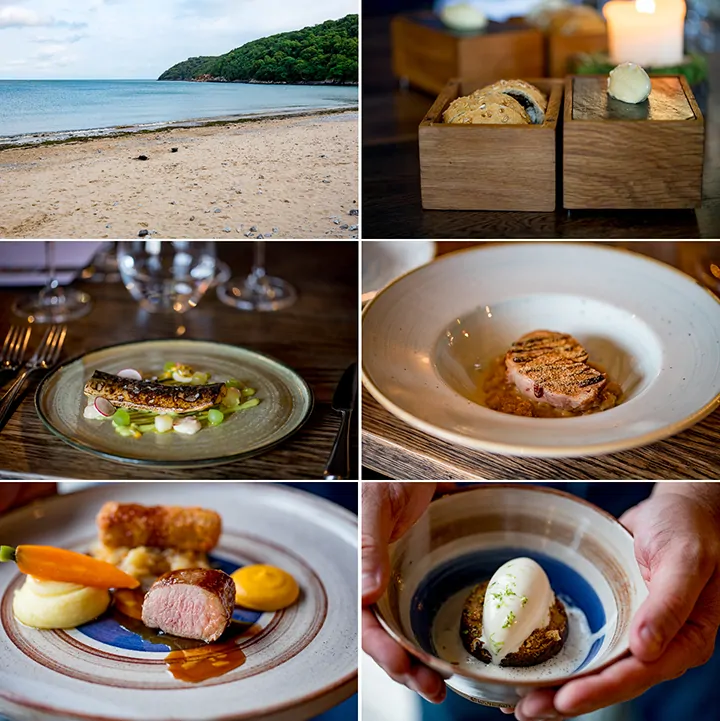
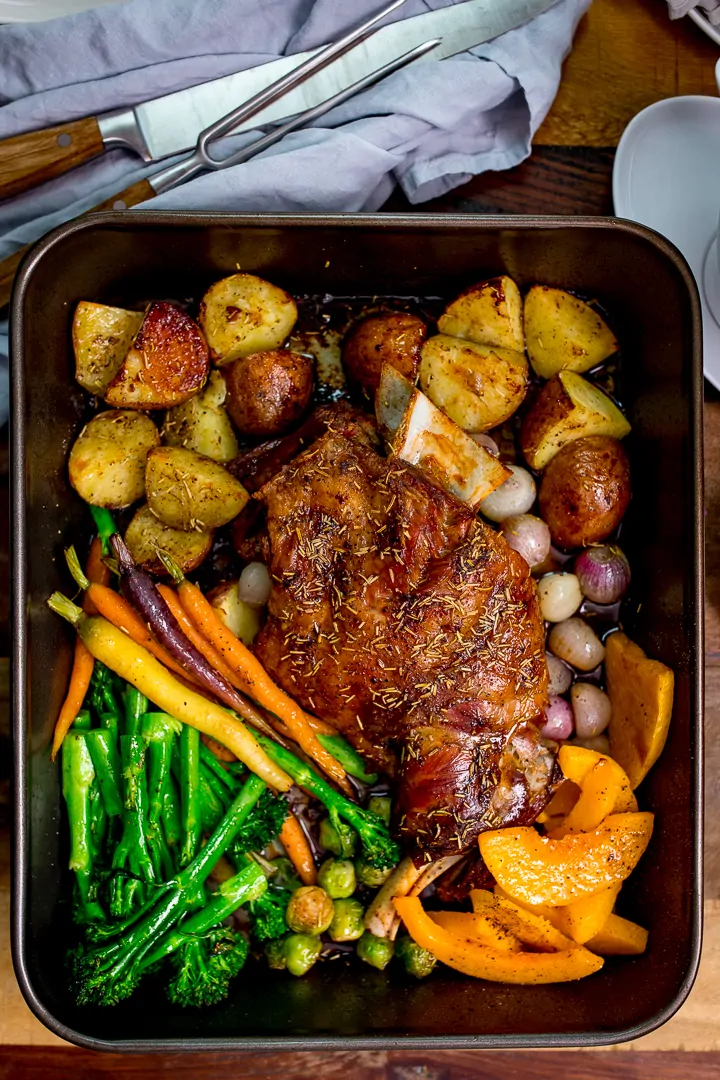
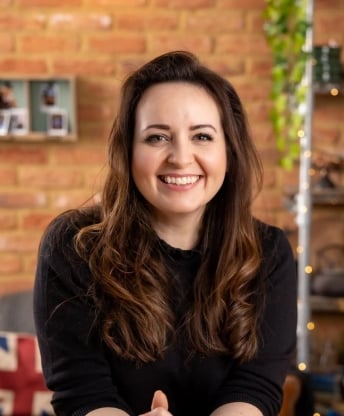
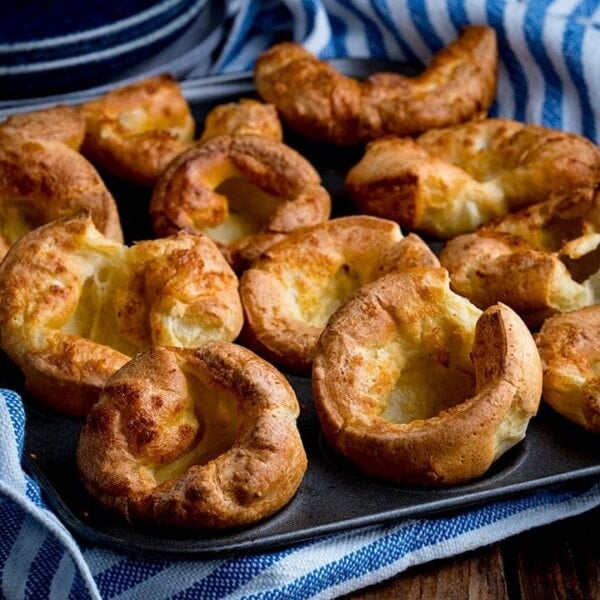
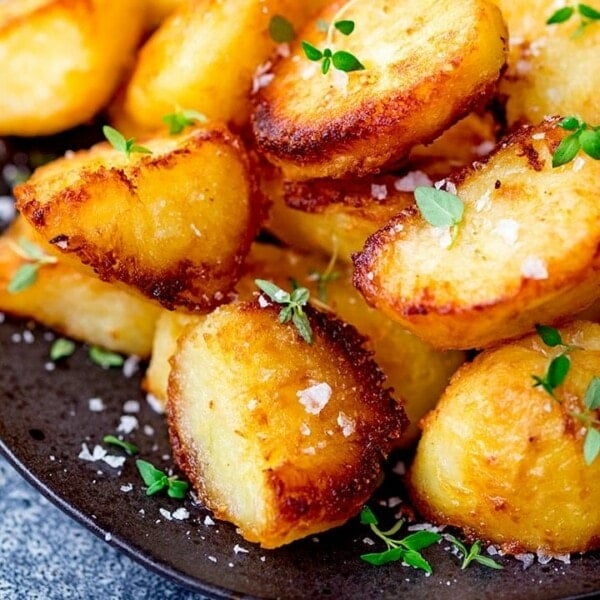
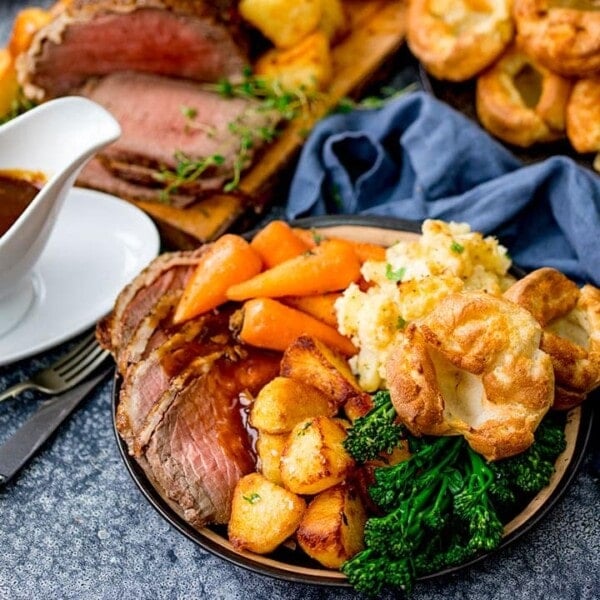
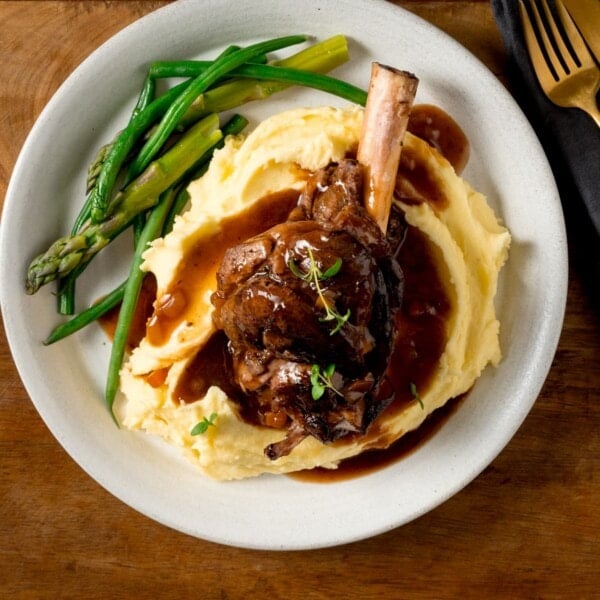
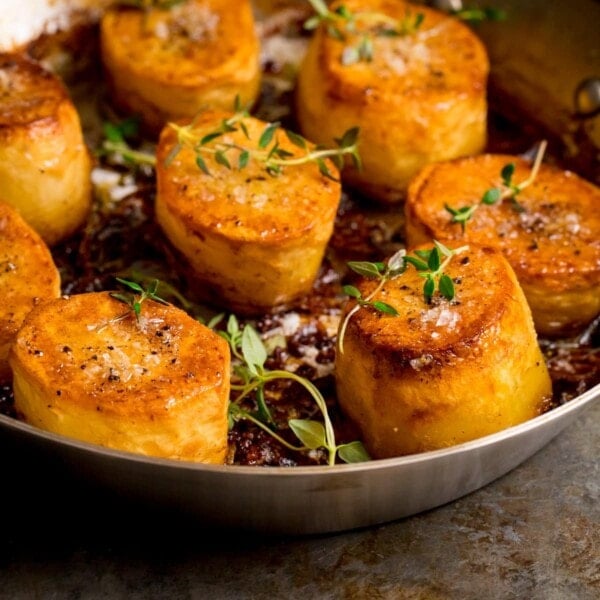
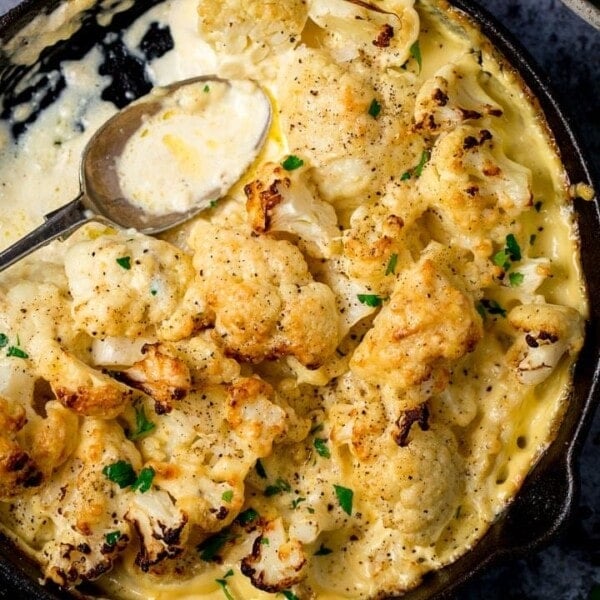
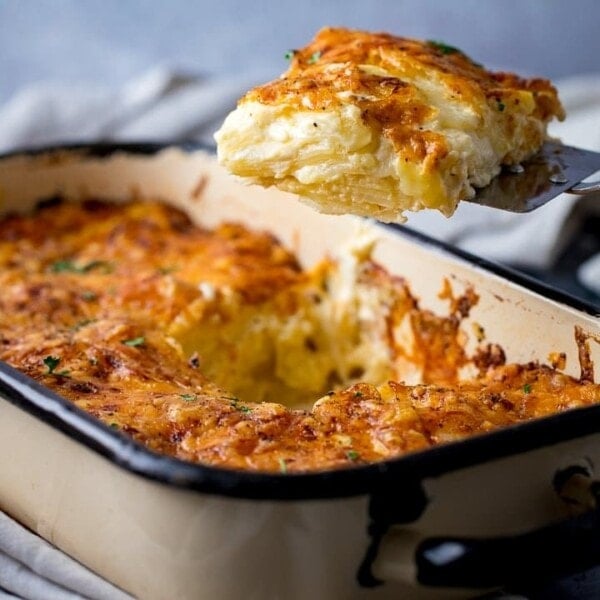
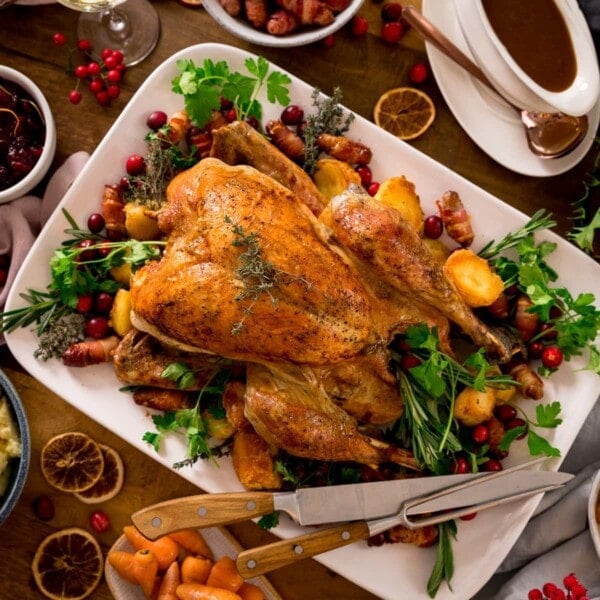







I cooked this for a dinner party and it was amazing! Cooking the vegetables in the meat juice is inspired , and all that is needed is the delicious cider gravy to pull the whole meal together. There was not a scrap of leftovers on anyone’s plate, so I would call that a resounding success. A highly recommended recipe and very easy on the host.
Potch- potato and swede boiled and mashed together to make a creamy smooth mash with milk and a nub of butter 😛.
I made this yesterday the meat fell off the bone and was delicious. I did parboil the, potato’s carrots and shallots in the morning, as always came out too raw. The cider gravy did go well. Empty plates all round.
Is this 180c with no fan? Does that make it 160c with fan oven? Is that too low for the hard veg to cook in that time? Please advise
I dont agree with the non par boil of the veg and especially the potatoes. You need to fluff them up to go crispy. You dont need an endless supply of pans and another sink. You use one pan of salted water and cook each veg off starting with the quickest and lightest coloured veg.. Put them all on a plate to cool or put in a bowl with a marinade. Veg like parsnips, swede, cauli steaks and carrots in soy sugar honey s and p with some oil. Tip the veg water away and use fresh water to par boil the pots. Start the lamb in a roasting tray with a pint of water and cook with foil on. Rub a little oil on the top of the lamb to stop the foil sticking. Cook for half the time then remove the foil and top up to the same level of water. Rub the meat around the tray to pick up all the gnarly bits. 3/4 through the cook pour off the stock into another pan. Add just a small amount of water to the roast tin to get the final sticky bits out. Return the lamb to finish off. Cook the potatoes separate in another tray. Dont fill it with oil, instead after draining the potatoes and drying out ,roll them around the pan to fluff up with enough oil to coat them, then straight into a hot tray. As they cook, turn and add the longest cooking time veg to the slowest to the tray. Time it right and the veggies will all be perfect and the lamb will have had half hour to rest. All your doing is washing up the potatoe pan the lamb tray and making a bit of gravy. using all the juices you have collected. Simmer and add either conrflour/water mix and maybe a touch of gravy browning. Or simply whisk in some reduced salt gravy granules, basically flavour colour and thickening. Much the same thing really. The intense stock you have made takes over any flavour of the granules. Add any juices flowing out the lamb to your stock as it rests. Your lamb will be succulent.. the potatoes will be crispy and your veg will be perfectly roasted without being drowned in oil and lamb fat. Personally i would be making a cauli cheese to go with my lamb. I did use to like Nans sticky roasties so you could add the pots to the lamb once you have removed the stock. I prefer crunchy potatoes for texture though… If your going to spend double the money on a shoulder of welsh lamb (the best in the world) then why wouldnt you push the boat out with the rest of dinner because you cant be bothered with a bit more washing up. What next… frozen veg with the xmas turkey…
Hi Dave, I’m all for doing a roast dinner with separate dishes/pans – to get the best result for each individual dish, and I love crispy roast potatoes (I’ve got a recipe on my site which includes parboiling and hot oil).
However, the point of this recipe is to make it easier for people who want to cook everything in one pan (which, yes, it does save on washing up, but also, it honestly does taste delicious, with the veggies soaking up the meat juices).
It’s also a great recipe for people who are intimidated by making a roast dinner and having lots of things going on a once.
I provide recipes to do all of these things separately. This is simply an alternative way of doing it.
I cook a full lamb roast dinner fairly often, and this is a nice way to change it up sometimes.
You’re a bit of a k*** end Dave. What type of person provides a completely different recipe in response to what is a fantastic meal?
Maybe start your own website?
Great recipe
Smashing dinner
I made the recipe as directed but it took forever for the vegetables to finish. I think next time I’ll roast the vegetables separately and at a higher temp. Flavor wise, it was delicious! I will definitely keep this recipe for future use! It’s a nice change from all the middle eastern flavors.
Hi Nicky!
Thank you for this delicious recipe. You are SO right Welsh lamb is The Best! I live in USA now which is more of a beef eating country but my childhood memories are of Mum making roast leg of Welsh Lamb at Easter (yes I read your comments). Still a superior cut of lamb and the taste out of this world. I cannot duplicate this recipe as I only have US of A lamb or New Zealand but I still remember those Welsh Lamb dinners! Amazing! Thank you:)
Hi, do you recommend a cider? Or can you use any such as ‘Strongbow Original’? Can’t wait to try this, thank you.
Hi Lewis, I like to use a dry cider (my favourite is Aspall), but strongbow will totally work 🙂